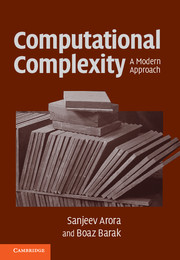Book contents
- Frontmatter
- Contents
- About this book
- Acknowledgments
- Introduction
- 0 Notational conventions
- PART ONE BASIC COMPLEXITY CLASSES
- 1 The computational model – and why it doesn't matter
- 2 NP and NP completeness
- 3 Diagonalization
- 4 Space complexity
- 5 The polynomial hierarchy and alternations
- 6 Boolean circuits
- 7 Randomized computation
- 8 Interactive proofs
- 9 Cryptography
- 10 Quantum computation
- 11 PCP theorem and hardness of approximation: An introduction
- PART TWO LOWER BOUNDS FOR CONCRETE COMPUTATIONAL MODELS
- PART THREE ADVANCED TOPICS
- Appendix: Mathematical background
- Hints and selected exercises
- Main theorems and definitions
- Bibliography
- Index
- Complexity class index
11 - PCP theorem and hardness of approximation: An introduction
from PART ONE - BASIC COMPLEXITY CLASSES
Published online by Cambridge University Press: 05 June 2012
- Frontmatter
- Contents
- About this book
- Acknowledgments
- Introduction
- 0 Notational conventions
- PART ONE BASIC COMPLEXITY CLASSES
- 1 The computational model – and why it doesn't matter
- 2 NP and NP completeness
- 3 Diagonalization
- 4 Space complexity
- 5 The polynomial hierarchy and alternations
- 6 Boolean circuits
- 7 Randomized computation
- 8 Interactive proofs
- 9 Cryptography
- 10 Quantum computation
- 11 PCP theorem and hardness of approximation: An introduction
- PART TWO LOWER BOUNDS FOR CONCRETE COMPUTATIONAL MODELS
- PART THREE ADVANCED TOPICS
- Appendix: Mathematical background
- Hints and selected exercises
- Main theorems and definitions
- Bibliography
- Index
- Complexity class index
Summary
[M]ost problem reductions do not create or preserve such gaps.… To create such a gap in the generic reduction (cf. Cook) … also seems doubtful. The intuitive reason is that computation is an inherently unstable, non-robust mathematical object, in the the sense that it can be turned from non-accepting to accepting by changes that would be insignificant in any reasonable metric.
– Papadimitriou and Yannakakis [PY88]The contribution of this paper is two-fold. First, a connection is shown between approximating the size of the largest clique in a graph and multiprover interactive proofs. Second, an efficient multiprover interactive proof for NP languages is constructed, where the verifier uses very few random bits and communication bits.
– Feige, Goldwasser, Lovász, Safra, and Szegedy [FGL+91]We give a new characterization of NP: it contains exactly those languages L for which membership proofs can be verified probabilistically in polynomial time using logarithmic number of random bits, and by reading a sub logarithmic number of bits from the proof.
– Arora and Safra [AS92]This chapter describes the PCP Theorem, a surprising discovery of complexity theory, with many implications to algorithm design. Since the discovery of NP-completeness in 1972 researchers had mulled over the issue of whether we can efficiently compute approximate solutions to NP-hard optimization problems. They failed to design such approximation algorithms for most problems (see Section 11.1 for an introduction to approximation algorithms). They then tried to show that computing approximate solutions is also hard, but apart from a few isolated successes this effort also stalled.
- Type
- Chapter
- Information
- Computational ComplexityA Modern Approach, pp. 237 - 256Publisher: Cambridge University PressPrint publication year: 2009



